
The wireless-telegraphy equipment of the Queen Mary was the largest and most complete ever installed in any ship afloat at the time of the Queen Mary’s maiden voyage in 1936. It allowed for constant communication with both Europe and America by telegraph, radio/telephone and broadcast radio during the entire North Atlantic crossing. It was designed and installed by the International Marine Radio Co., Ltd., of London.
Map showing original layout of the wireless rooms and their associated residence areas. Click on the image to expand it.
According to the "Shipbuilder" "the weight of the transmitters and receivers alone exceeded a total of 11 tons. The original installation was divided into two primary functions and locations on Sun deck.
The Transmitting Room - essentially an unmanned equipment room was located on the port side of the ship just forward of the Verandah Grill.
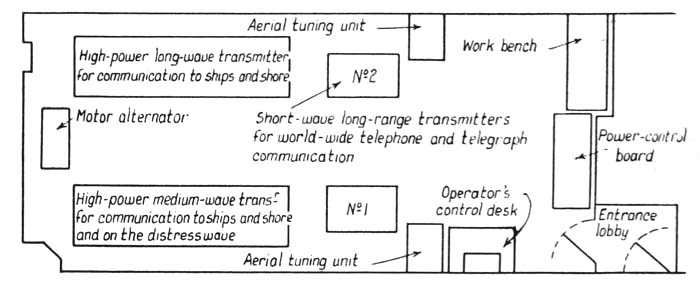
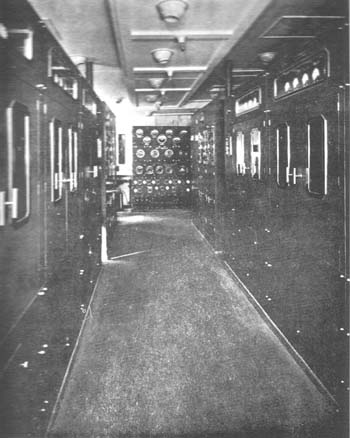 |
|
| The Radio Transmitter Room | The IMRC Radio Transmitter from the front (above), and the rear (below). |
According to the "Shipbuilder" the transmitting installation included:
The Receiving Room - was located some 250 ft forward of the transmitting room on Sun Deck, it was forward of the prewar Squash Court. It was here that both telegraph and radio/telephone messages were actually initiated. It is also where telegraph messages were received.
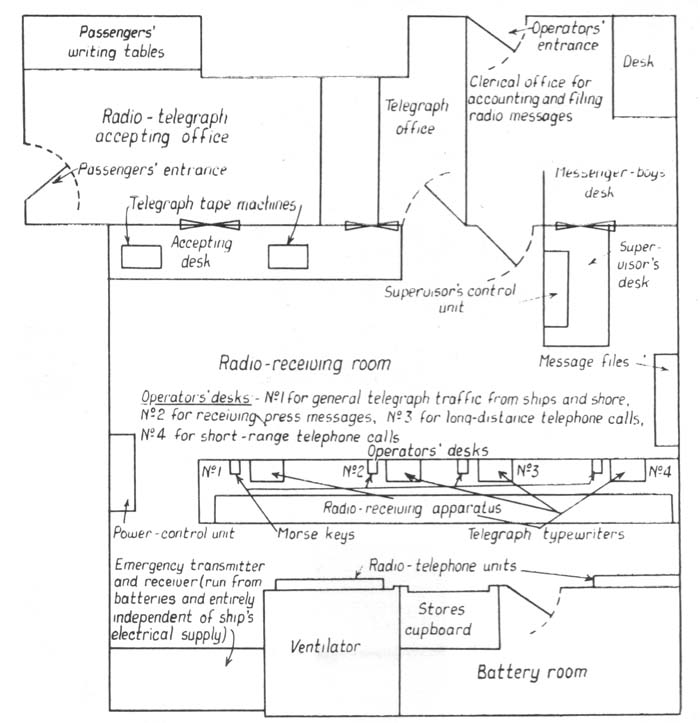
According to the "Shipbuilder" eight sets of receiving apparatus were installed here with four operator positions arranged at a table, a telegraph typewriter and a Morse key being provided at each operator position.
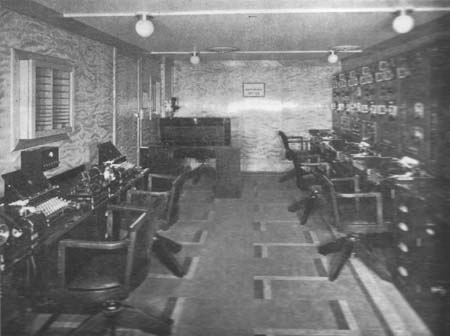
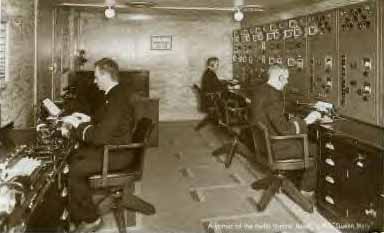
The Receiving Room shown unmanned and manned in a postcard sold on board.
All four positions were able to handle telegraph operator on all waves.
The emergency transmitting equipment and power supply was installed in an adjacent compartment. Its range was at least 500 miles and was comparable to the type then in use as the main wireless installation of smaller vessels. A generating plant was located adjacent to the radio receiving equipment in this suite and an auxiliary power source composed of 24 Exide batteries, not connected to the ship’s main current, was also located nearby in this same suite.
Radio Officers' Quarters – there were four small center ship cabins located just forward of the Receiving Room on Sun Deck for the junior radio officers. Four more were located further forward with portholes overlooking the bow for senior radio officers.
Aerials – 10 independent aerials were in place on the Queen Mary.
1936 - 1939 - The wireless system worked as described above
1940 - 1947 - During this period the Queen Mary served as a troop transport.
1947 - 1967 - Passenger operations were resumed after a major refit and refurbishment to the Queen Mary. During that refit the portside first class writing room on Promenade deck was enclosed and converted to a passenger radio/telephone reception room. This change underscores the growing importance of telecommunications in the twentieth century. Here passengers of all classes could come for a prearranged long distance telephone calls. (Most but not all first class passengers had telephones in their cabin from which to place calls. Those in second and third class did not.)
Over the years some updates to the equipment took place as well. As Ken Mugridge, a Radio Officer on the Queen Mary in the 1960’s tells us:
"When I sailed aboard her in 1961, all the equipment was vacuum tubes (or valves, as we Brits called them) It sometimes got really hot in there, as tubes chuck out a lot of heat. Most of the equipment was custom built by my company, International Marine Radio Company, although I did use, as a main receiver, an Eddystone (famous British company, named after the lighthouse) Mackay Radio (a U.S. company) also had some equipment aboard. Around 1967, big changes occurred in the marine electronic business. Some equipment was hybrid, i.e. mixture of tubes and transistors. It is possible that some of this equipment made its way aboard, but this was after my time.
Most of our radio work was done via Morse code. Weather reports, navigational warnings & telegrams etc.
We also had radio telephone facilities on board, the transmitters being housed aft in the transmitting room. Not all first class cabins had telephones. That was the reason Cunard opened up the radio office on the prom deck. One of the senior Radio Officers (not me) would go down there, with a radio messenger at specific times and take bookings for telephone calls, together with accepting telegrams from non-first class passengers. The crew also were allowed to use these facilities to make phone calls. I think they had to be pretty urgent, to warrant the cost - around $4 a minute.
We used to try to book time slots or "stack" the passengers for telephone calls, as getting a "circuit" sometimes involved a lot of time.
We live today in an age of instant communication and it’s hard to realize that only 30 odd years ago, it was totally different. We relied on short wave (High Frequency) propagation. For instance, making a phone call to New York from mid Atlantic involved first calling up the big land radio station at Ocean Gate, New Jersey (call sign WOO), via Morse code. We then established contact with the technician and got a scratchy phone circuit established after first playing around with the best HF frequency for that particular time of day (this also involved reading ionosphere propagation charts). The land technician would then ask our position so he could swing round his directional antennas onto us. This usually made a big difference. When the circuit was judged commercially acceptable, we would then be patched through to the main ocean telephone exchange in New York. At this time we would phone down to the prom deck office to the R/O and yell "Ok with Woo" and he would go ahead.
This effort sometimes took a couple of hours, so you can see the reason for stacking up passengers. Sometimes WOO would cut us off if the circuit got bad as there were much better equipped ships on the Atlantic impatiently waiting, that could get through. The new Italian liners such as the "Leonardo da Vinci" and the "Christoforo Columbo" had really modern radio equipment. The SS "United States" was another that did. Our equipment was pretty old by the sixties. There was one permanent technician assigned to radio operations, but we all used to muck in if we had a major breakdown.
The telephones and telephone exchange were maintained by the electrical engineers. The girls who worked the switchboard were always very popular with the Engineers."
Click here to listen to part of a recording of a wireless transmission from the Queen Mary as it left New York for the last time in 1967. The file is 550kb and can take a while to load.
The message reads:
TO MANAGER AND STAFF WSC TUCKERTONRADIO // AS WE TAKE OUR LEAVE OF NEWYORK AND REGRETFULLY STEAM DOWN THE HUDSON FOR THE LAST TIME WE SEND YOU ALL OUR THANKS AND APPRECIATION FOR THE COOPERATION EXTENDED TO US OVER THE YEARS BEST WISHES AND OUR KINDEST REGARDS // RADIO STAFF GBTT+
WSC replies
GBTT DE WSC SVC R R AND MANY TKS OM
(Service Roger Roger and many thanks Old Man)
RR NW SHOOT K
(Roger Roger - Shoot (=send all your messages) K (=invitation to transmit))
WSC replies:
R R THIS SEEMS SAD MOM -
To read about the very final transmission from the QM's Radio Room GO TO:
1968 to present – after the Queen Mary arrived in Long Beach the ship’s radio operations were shut down. Her signal letters, GBTT, were taken over by the then new Queen Elizabeth 2. The original wireless installation was dismantled. Some of the equipment did not belong to Cunard and was exempted from the sale of the ship.
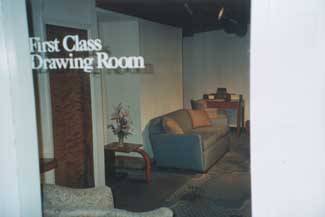
|
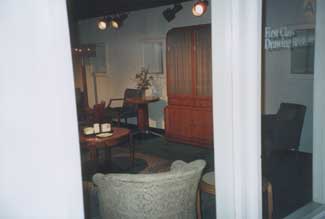
|
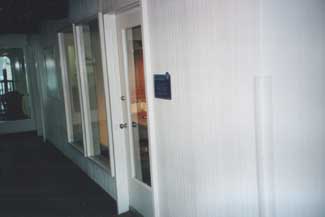
|
The main portion of the Radio Receiving Room when it housed an Exhibit labeled "First Class Drawing Room". It contained furniture saved from various lounges. |
The original veneered door on the right in the above photo leads to the Battery Room. The current condition is illustrated below. The first view is facing aft, the second facing forward.
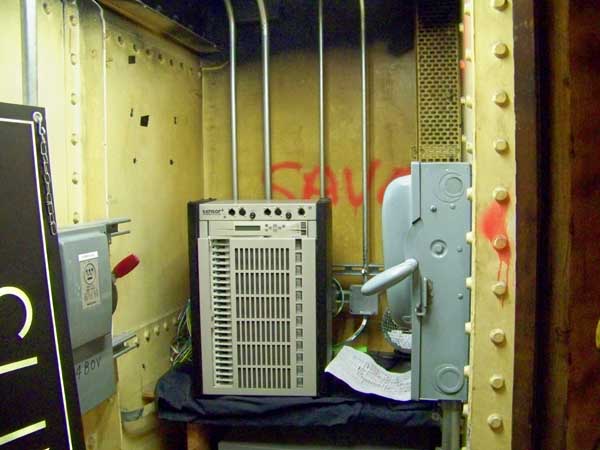
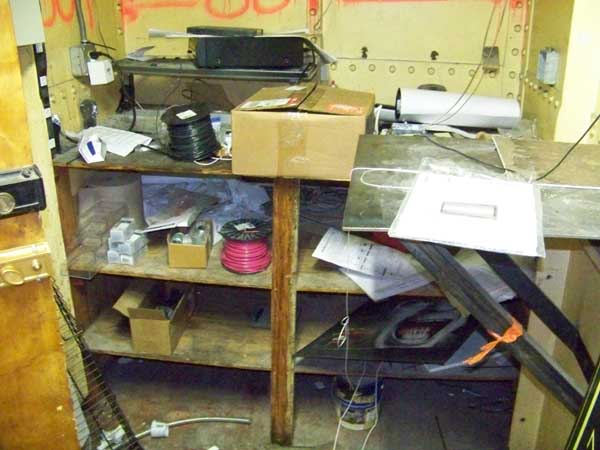
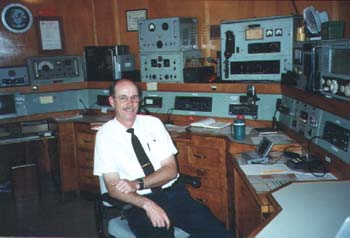
Left - Volunteer work helps keep the Radio Room tradition alive today
After the converted ship was opened to the public in the early 1970’s an amateur ham operator’s club was installed in a section of what was once the observation platform of the Racquets Court. This club's operation is located on Sports deck. Surviving pieces of Queen Mary equipment are displayed here on a shelf above the contemporary working short wave equipment. This club of dedicated amateurs boasts a membership of over 150 and provides a core of dedicated volunteers that man this ham operator radio room display that is labeled the "radio room."
According to Ken Mugridge, "When I last went aboard the Queen Mary around 1982, I visited the amateur radio shack but the door was locked. I peeked in through the window and recognized an IMR Co. emergency transmitter on a shelf, together with what looked like an old Mackay Radio receiver. I also saw the transmitter that was installed in the wireless room for use in an emergency, should all the power fail. It transmitted on 500 khz & worked off 24v batteries.
Left - A display of Queen Mary mail and wireless messages
Right - The Exterior of the modern Ham radio Club today
The amateur radio facility would never have been allowed on QM, while it was sailing with Cunard. We did get the occasional radio amateur passenger come in for a tour and sometimes we would let them just hit the transmitting key for a half second or so. They really liked that. ‘Better than driving the ship,’ we said." Further reminiscences can be read here.
Today the walls of the principal room of the Wireless Reception Suite remain largely intact on Sun deck. The deconstructed passenger reception and managers offices might easily be reinstalled.
 Deckplan illustrating our preservation and adaptive reuse plan Option B
Deckplan illustrating our preservation and adaptive reuse plan Option B
Our Sun Deck proposed Deckplan - Click to expand to full size.
While restoring the physical confines of the Wireless Operation Reception Suite is a fairly simply task, finding original or like radio equipment is more challenging. And putting the real wireless equipment back into operations like on the nearby World War II vintage "Lane Victory," raises intriguing questions. (For more information about the radio operations on the S.S. Lane Victory please go to their website at http://www.lanevictory.org/ Both the original radio room with virtually all original equipment in working order and an amateur ham radio operations are found functioning onboard.)
Points to note regarding the Queen Mary's situation:
The original wireless transmission room by the Verandah Grill was totally removed. Because of its distant location and current use it is not a likely candidate for restoration. But since the wireless reception room also contained emergency transmission equipment the restoration of the transmission room is not necessary for the wireless operation to go "live" with original equipment.
As noted in the "Shipbuilder" earlier in this article, the emergency transmission equipment that was found in the radio reception suite had a range that was "comparable to the type then in use as the main wireless installation on a smaller vessel. A generating plant was located adjacent to the radio receiving equipment in this suite. An auxiliary power source composed of 24 Exide batteries, not connected to the ship’s main current, was also located nearby in this same suite."
As Ken Mugridge, a radio officer of the Queen Mary points out, "there are a number of challenges with using QM's original radio equipment, even if it can be located and put in working order. The main one is legal.
"As challenging as it might be, we believe that the original radio room operation, just like the remaining original engine room and the other aspects of the power train, if they are ever restored, would be major attractions on the Queen Mary. People are always fascinated by technology."
Clearly the possibilities are as intriguing as the issues are challenging.
The amateur radio shack operation that has been in operation on the Queen Mary since the 1970’s might help man this enlarged exhibit and if the Squash Court is restored, as we propose, then their contemporary working equipment might be reused in a new more working exhibit area in the water tower just behind the wheelhouse.
If full restoration with the original or like equipment isn’t feasible, then housing the ham radio operation here would be the most appropriate (and sustainable) use of this room over all of the short term failures that have come and gone.
There is a very comprehensive article on the Queen Mary's radio equipment hosted on this site, kindly submitted by Geoff Dyson in 2005. To read it click here.
See the article on the "Wheelhouse of the Queen Mary."
![]() Return to Index by Deck
Return to Index by Deck
![]() Return to
Index by Class of Accommodations
Return to
Index by Class of Accommodations